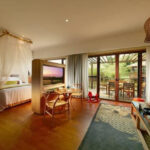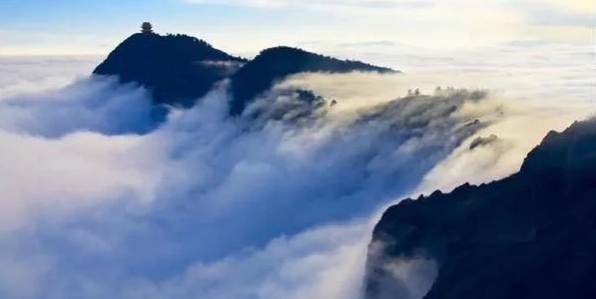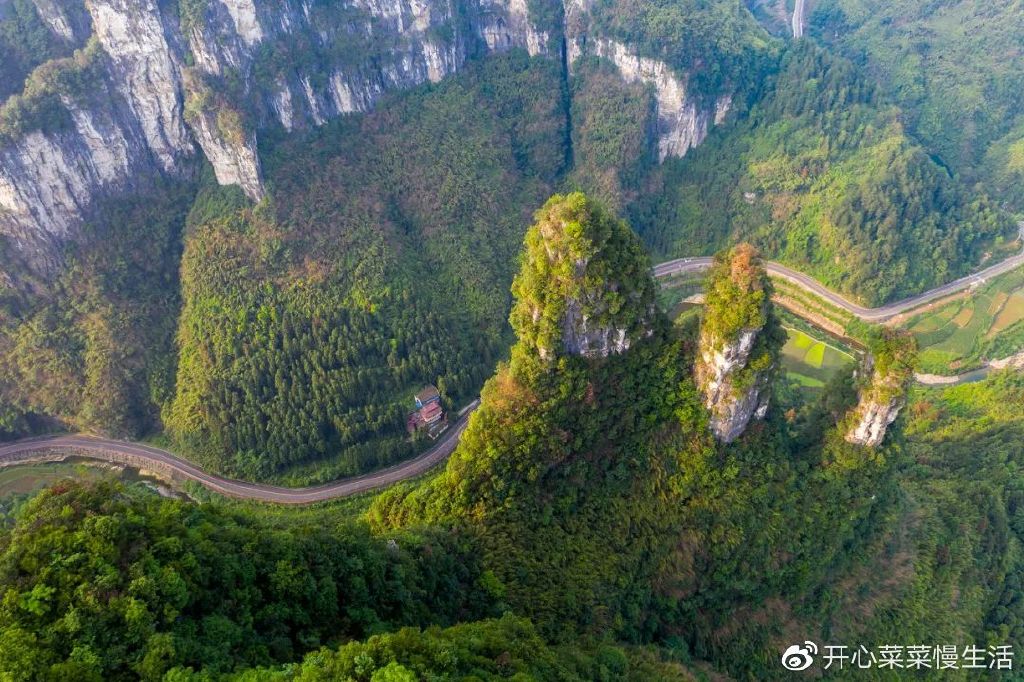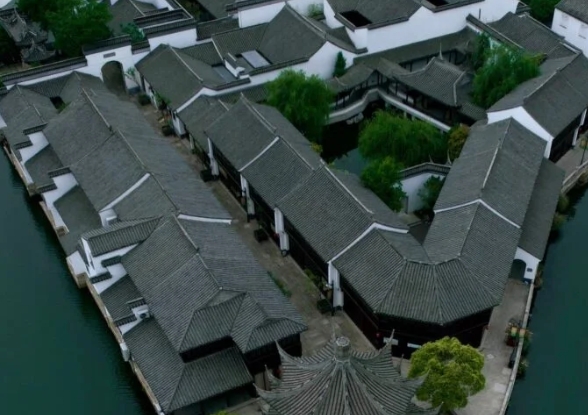When a friend inquired about interesting places in Jiangxi, I was quick to respond with enthusiasm. “There are far too many to mention!” I exclaimed. From the renowned Lushan in Jiujiang and Longhu Mountain in Yingtan, to the Tengwang Pavilion in Nanchang and the rapeseed flowers in Wuyuan, the Porcelain Capital Jingdezhen is also a must-visit. But the one I highly recommend next is the ‘Jiangnan Song City, the Cradle of Hakka’—Ganzhou, the second-largest city in Jiangxi.
This winter, I spent a week traveling across Ganzhou and would like to share with you the scenic beauty, ancient charm, and modern vitality of this delightful Hakka cradle.
To truly explore Ganzhou, one must start with the city area known as Jiangnan Song City. Upon arrival, locals will undoubtedly recommend the most famous attraction: the renowned Ba Jing Tai, located at the confluence of the Gan River, Zhang River, and Gong River. Ba Jing Tai is situated on the ancient city wall at the northeastern corner of the old city of Ganzhou, constructed during the Northern Song Dynasty’s Jia You era. It was named after the prefect Kong Zonghan, who built the platform and drew the ‘Qianzhou Ba Jing Tu’ (Qianzhou Eight Views Map), from which he sought poems from Su Shi. Climbing up Ba Jing Tai, one can take in the panoramic views of the eight scenic spots of Ganzhou, as if immersed in the scene, hence the name.
Here, a piece of Song Dynasty’s ancient city brick remains. Strolling along the city wall, quietly exploring the calligraphy and traces left by ancient celebrities in Ganzhou, this is a city full of life and rich historical accumulation. ‘One Ganzhou city, half of the Song Dynasty history.’ Ganzhou, also known as ‘Qianzhou’, the southern gateway of Jiangxi, was one of the 36 major cities during the Song Dynasty, holding the strategic junction of the five ridges, controlling the vital points of Gan, Min, Yue, and Xiang, and has been a strategic location since ancient times for ‘connecting the south and north, calling the east and west, calming the Baiyue, and looking north to the Central Plains’.
The three rivers flow day and night, the eight scenes age gracefully. Tall buildings are lined among the clouds, and long bridges float on the water. — Guo Moruo ‘Climbing Ba Jing Tai in Ganzhou City’. Ganzhou, where the Gong River, Gan River, and Zhang River converge, was once a flourishing Jiangnan city during the Song Dynasty and ranked among the top thirty states in the country. Now, it appears to be too low-key.
The ancient city wall of Ganzhou, originally built during the Han Dynasty, has a history of two thousand years. It has been continuously repaired and strengthened through the Southern Song, Yuan, Ming, Qing, and Republic of China for more than 900 years, forming a city wall with a circumference of about 13 li, tall and majestic, reflecting the intelligence and superb architectural skills of the ancient Chinese working people. The relatively well-preserved ancient city wall, built during the Northern Song Dynasty’s Jia You era, is the largest existing ancient city wall in Jiangnan and one of the few Northern Song Dynasty brick walls in the country. The city wall averages 7 meters in height, stretching 3.6 kilometers from the east gate to the west gate, with the crenelated walls, artillery fortresses, horse faces, and city gates all well preserved.
Next to the Jianchun Gate of the ancient city wall, there is also a must-visit spot for Ganzhou travel, the Ganzhou Ancient Floating Bridge. This floating bridge, about 400 meters long, connects the two ends of the Gong River and is made up of more than 100 small boat planks tied together with cables. It was first built during the Song Dynasty’s Qian Dao era and has a history of more than 800 years. The entire floating bridge is divided into 33 groups, connected by cables, and then fixed on the river surface with steel cables and iron anchors. The neat array still looks very spectacular.
There are many boats moored next to the floating bridge, this is the famous riverside fishing home next to the floating bridge, not the kind of fishing home that is a restaurant, but a fishing home that relies on catching fish from the three rivers for processing and selling, which again reveals the strong life and humanistic colors of Ganzhou. Rows of dried fish of various sizes, all kinds of small fish and shrimp are neatly arranged waiting for customers’ favor, and some tourist souvenirs are also sold together, looking very pleasing. The busy fisherwoman is scaling the freshly caught large carps, mentioning they are supplied to the restaurants by the river. Seeing these lively Ganjiang carps, one can’tEntering the ancient city of Ganzhou feels like being in a ‘Song City Museum,’ hence the reputation of ‘Jiangnan Song City.’
The current Ganzhou ancient city, once known as Qizhou Song City, began in the Sui Dynasty and flourished in the Song Dynasty, with a history of more than two thousand years. It is also the poetic Jiangnan described by Su Shi and Xin Qiji, where Huizhou architecture blends with Gannan Hakka style, and the restored blocks reproduce the prosperity of the past.
In Jiangnan Song City, one can wander through ancient cities, stay on Song streets, cross Song bridges, view the eight scenic spots, and wear Song costumes, enjoying the bustling life amidst the world.
Jiangnan Song City offers several night tour routes with a rich variety of visiting and experiencing projects. The core highlights include historical and cultural landscapes such as Yugu Terrace and Song city walls, cultural performances like soldier parades and embroidered ball selection for marriage, intangible cultural heritage experiences such as Gannan tea picking, Hakka tea pounding, and making Huangyuan rice cakes, as well as technological cultural tourism products like the Military Gate Tower 3D projection show and laser water dance show.
The famous night view of Jiangnan Song City can only be seen at night, so one can continue to stroll through the old city. By chance, one steps into Zao’er Alley, where several children ride by on their bikes, creating a contrast between the ancient streets and the young generation.
Zao’er Alley is located in the eastern part of Ganzhou city, the eastern section of the Yin Street of Song Ganzhou, with a total length of 227 meters. It connects with Heping Road in the southwest, Liuhepu Street in the northeast, and passes through Laoguxiang. It features Gannan Hakka architecture, Ganzhou courtyard-style architecture, Huizhou architecture, and Western-style architecture. Zao’er Alley is a typical representative of the many historical and cultural alleys preserved in Ganzhou, known as Jiangjia Alley during the Ming Dynasty. In the early Qing Dynasty, many officers lived here, and their uniform was black, called ‘zao’ color, hence they were called ‘zao officers,’ and the place they lived was called ‘zao alley.’ Later, the name became ‘zao’er alley’ due to homophonic changes.
Remembering the prosperity of the past and seeing the decay of the present, Zao’er Alley has fallen into disrepair over the vicissitudes of time and urgently needs protection. As an important scenic spot in Ganzhou’s ancient city that must be visited, we hope that Zao’er Alley will be quickly renovated and regain its former glory!
Ganzhou on a rainy night. Jiangnan Song City | Time-traveling back to the Song Dynasty amidst the blurred lights and shadows.
Because it’s a rainy night, there are really not many people, but it is said that it is usually a bustling ancient city that must be photographed and checked in. Tang poems and Song lyrics float in the sky, in this colorful and dazzling night…
After a day of shopping, I’m also hungry, and there happens to be a restaurant said to be the best in Ganzhou right here, so I’ll go and have a look.
Ganzhou Tourism Food Card | Hakka Courtyard. Intangible Cultural Heritage of Gannan Hakka Cuisine is located at Yugu Terrace in Jiangnan Song City, Ganzhou’s food card, where many intangible cultural heritages of Gannan dishes and Hakka dishes can be tasted here. To summarize first, Ganzhou’s dishes are simple in appearance, rich in taste, and quite spicy. It’s not obvious on the surface, but the spiciness is very low-key and connotative, just like the city of Ganzhou, small but powerful!
Ganzhou is one of the birthplaces of Hakka culinary culture, which originated from the Central Plains. The dishes reflect the genetic influence of northern Chinese cuisine and are the result of the fusion of traditional Central Plains culture with the indigenous culture of Ganzhou. It began during the Jin Dynasty and matured during the Ming and Qing Dynasties.
Dishes such as Banded Hui Chang Dried Tofu, Xingguo Mixed Fish Shreds, Ningdu Sanbei Chicken, Dingnan Sour Wine Local Duck, Ganzhou Quick Fried Fish, Nankang Lotus Wrapped, Casserole Beef Brisket, Crispy Lamb Chops, Sauerkraut Stir-fried Qing Pian, Assorted Fine Cured Meats Platter, Chive Stir-fried Bean Cake, Vegetarian Stir-fried Bean Curd Skin, Country Fried Tofu, Fried Assorted Dishes, Wine Pepper Purple Sweet Potatoes, Organic Sweetheart Vegetables, Ruijin Beef Soup, Hakka Glutinous Rice Cake, and Shicheng Taro Dumplings are particularly abundant, especially the Ningdu SanbeiThe next day, the scene is filled with red prosperity. With drums and firecrackers, a large-scale cultural tourism consumption festival celebrating the Hakka New Year in Ganzhou is grandly opened at the Hakka Cultural City, not far from the urban area of Ganzhou.
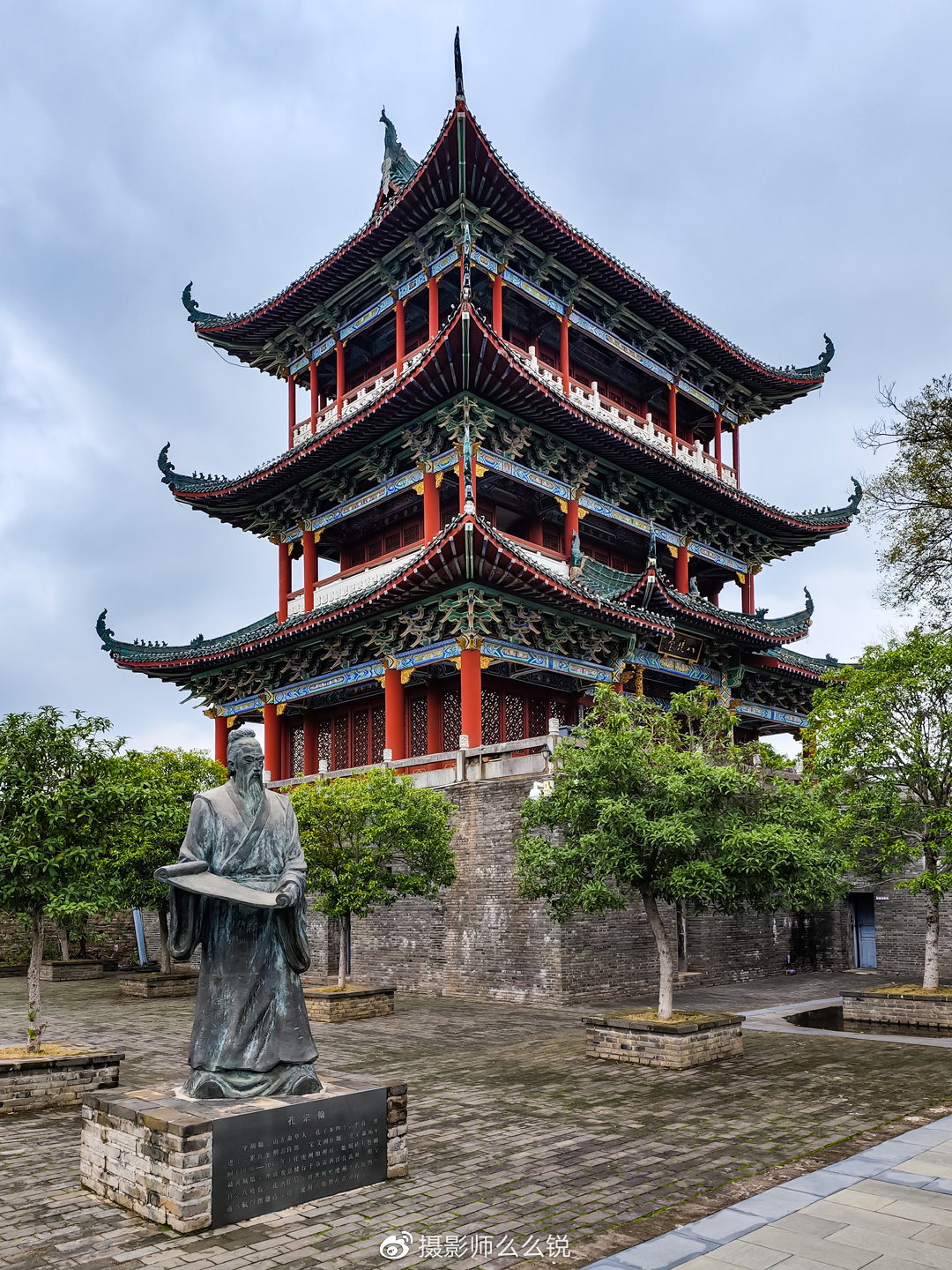
The Hakka Cultural City is located in the southeast of Gancheng County, south of the winding Gong River, overlooking the famous peak of Mount Gongnan in southern Jiangxi. It is a geomantically blessed land and the first comprehensive Hakka culture-themed museum in Jiangxi Province. The overall design of the park is square outside and round inside. The architectural style not only adheres to traditional cultural architectural concepts but also combines strong local humanistic characteristics. It integrates sacrificial celebrations, cultural exhibitions, business activities, and leisure entertainment. It is currently the largest and most functional Hakka cultural complex in China. It can be considered a focal point of Hakka culture, a ‘Grand View Garden’ for showcasing Hakka culture, and a ‘spiritual home’ for the Hakka people.
Today’s Hakka Cultural City has gathered almost all the delicacies and intangible cultural heritage skills of Ganzhou city and county. We decided to first experience the atmosphere here. Then we will move towards the vast landscapes and villages of Ganzhou city and county to feel the rich Hakka New Year atmosphere and the charm of the cradle of Hakka culture.
Here, you can not only prepare for the New Year’s goods but also experience more interesting traditional intangible cultural heritages such as Huangyuan Rice Cake, Yangbu Bean Curd, and Shahe Board Duck, and other traditional intangible cultural skills of southern Jiangxi. It is truly eye-opening. There are so many delicious and beautiful things that I almost can’t move my legs.
In addition to the wonderful inheritance of intangible cultural heritage, which is the essence of history left by ancestors, Ganzhou has never lacked innovative creations. The first high-tech theme park of red culture in the country – Fangte Oriental Dawn, you must come and enjoy it.
Ganzhou Fangte Oriental Dawn is a poem of the great journey of national rejuvenation. Here, the visual feast with great impact makes the red culture ‘shining’. Here, ‘visitors’ become ‘participants’, ‘appreciators’ become ‘comprehenders’, and ‘transmitters’ become ‘inheritors’. The atmosphere of patriotism is very warm, and it is very touching to watch!
Here, you can revisit the grandeur of the ‘Garden of All Gardens’ in the ‘Old Summer Palace’; follow the Zhiyuan ship in the ‘Zhiyuan Zhiyuan’; witness the great changes and take-off after the establishment of New China in ‘Songs of the Years’; overlook the famous mountains and rivers of the motherland in ‘Flying’, and witness the significant achievements made by New China in rapid development; and experience an exciting simulated journey of the ‘Liaoning Ship’ fighter jet take-off and landing on the roller coaster in ‘Eagle Strike the Sky’.
The large spherical cinema ‘Flight’ is particularly popular. It takes us on a ‘flight’ over the land of China, overlooking the famous mountains and rivers of the motherland, appreciating the magnificent natural scenery, flying over the Three Gorges Dam, the Beipan River Bridge, and other super engineering projects, and admiring the brilliant achievements of China’s rapid development. It is spectacular and shocking.
There are many exciting projects such as ‘Breakthrough’, ‘Aspiring, Aspiring’, and ‘Heroines’ waiting for you to experience. I won’t ‘spoil’ too much. In short, Dawn of the East is a place where you can have a thrilling day full of surprises.
Here, there are more than ten exclusive indoor large-scale high-tech themed projects and more than twenty outdoor amusement projects created by Fantawild. There are also several themed blocks such as Hong Kong Street, Shanghai Street, Beiping Street, Ruijin Street, which restore the social and cultural characteristics of different periods of modern China. And there are hundreds of characteristic leisure landscapes, themed restaurants, shops, etc. It provides a one-stop destination for dining, entertainment, and shopping. It is truly exceptional.
Reluctantly leaving Fantawild Dawn of the East, you step into the blue Arctic Ocean World.The children of Ganzhou are indeed fortunate to have such a delightful place for family entertainment—the stunning and engaging Arctic Ocean World. Having visited numerous Arctic oceanariums around the globe, I can confidently say that many do not compare to the one in Ganzhou. For instance, do the oceanariums you frequent feature four dolphins performing synchronized leaps? Do they offer a variety of stylish sea lion performances? Is the mermaid show sufficiently lengthy? Are the aquarium windows consistently clean? Many fail in these aspects, but Ganzhou’s oceanarium excels.
The facility boasts nine exhibition areas, three performances, and five interactive experiences: the Amazon Tropical Rainforest Area, Tide Area, Marine Coral Reef Fish Area, Fierce Shark Area, Underwater Tunnel Area, Polar Animal Area, Dream Jellyfish Area, Science Popularization Exhibition Experience Area, and more. The Dolphin Bay Theater, Beluga Love Theater, and Mermaid Theater showcase exciting performances by sea lions, dolphins, belugas, mermaids, and Russian underwater ballet, captivating audiences of all ages.
Though the scale may not match that of first-tier city aquariums, it is more than adequate for children to appreciate the splendor of the ocean world. I wholeheartedly recommend this place, and believe a trip to Ganzhou is well worth the visit.
After spending two full days in Ganzhou city, it’s time to take a break from the hustle and bustle and immerse ourselves in nature, venturing into the countryside. We are eager to explore the picturesque rural areas of Ganzhou County and experience the beauty of Ganzhou’s pristine mountains and waters.
Our first stop in the beautiful countryside is Qiankun Town in Longnan, a national AAAA-level tourist attraction. Nestled at the northeastern foot of Jiulianshan, a national nature reserve and national forest park in Jiangxi, the town is themed around ‘Qian’ culture. It leverages its unique ecological agriculture, coupled with abundant resources of mountains, water, tea, and bamboo, to create a leisure vacation experience base that integrates natural scenery, pastoral scenery, Hakka customs, and Qiantea culture, making it a tourist town that blends agriculture and tourism.
Hakka people reside here in clusters, and it is said that Wang Yangming once practiced spiritual cultivation, educated the locals, and taught Neo-Confucianism in this area. Upon arrival, following the rain, the mountains were enveloped in mist, and the air was incredibly fresh—a perfect environment for cultivating immortality. Strolling through Baixiang Valley in Qianxin Town, one finds old jars of Qianjiu scattered across the mountainside, creating a spectacular sight. Qianjiu Manor · Baixiang Valley offers a fresh take on Maotai-flavor liquor culture, merging traditional brewing techniques with modern display methods, adding a touch of style and joy to the experience.
In the rain, the scenery is akin to a fairyland on earth. There is also an old liquor bank here, a natural creation and heavenly brew. Seal your beloved liquor with time, and when the moment is right, share it with family and friends, deepening friendships and enhancing human joy. This creative idea is truly excellent, and I am tempted to purchase a jar of old liquor to store here. Beyond fine liquor, Qianxin Town also features numerous folk customs inheritances, such as the fragrant kiln-roasted chicken processing, making tofu by grinding soybeans and picking yuba, and traditional rice wine making and pounding glutinous rice cakes. This allows visitors to not only enjoy the beautiful natural landscapes but also taste and experience the local snacks’ heritage.
In the dense bamboo forest at night, a grand meal awaits us. The bamboo forest banquet in Qianxin Town selects pollution-free and healthy ingredients and unique seasonal fruits and vegetables of Longnan. Under the chef’s careful preparation, we can quietly savor delicious food amidst nature. Each dish, inheriting ancient craftsmanship, is a culinary delight. The recommended dishes include stewed bamboo in ganoderma lucidum, braised dried string beans, stir-fried cured pork with winter bamboo shoots, chopped pepper and white silk fish, fresh mushrooms stuffed with shrimps, Fengyan pearls, thick soup with yuba, beef trotters pot, flavored goose, frog and chicken treasure, stir-fried sweet beans and lilies, stir-fried Stenoloma chusanense, shredded bamboo shoots and mixed vegetables, tea-flavored crispy bones, braised pork, fresh chicken feet and pork stew, stir-fried beef with lotus shoot tips, steamed pressed salted duck, beef offal pot, stir-fried chicken giblets with black bean noodles, wild jujube cake, bean paste cake, and bamboo tube rice. These distinctive Hakka dishes are all worth savoring carefully.Embarking on a journey through the lush landscapes of southern Jiangxi, we first find ourselves in the serene embrace of a bamboo forest, where the simple stone steps and poetic winding paths lead us to a secluded haven that feels both ancient and timeless. The second stop on our picturesque tour is Longnan’s Zhixi Valley in Dongkeng Village, a place that has fully harnessed the essence of its unique traditional culture and ancient craftsmanship. Utilizing the natural bounty of mountains, water, and fields, Zhixi Valley has crafted a circular experience tour for rural revitalization, themed around ‘paper and craftsman’, ‘bamboo and gentleman’, ‘tea and rest’, ‘ecological agriculture’, and ‘red post station’. The tea culture-characterized homestay leaves a deep impression, with its leisurely courtyard landscaping and the pattering light rain enhancing its literary and artistic ambiance. The architecture, with its bamboo, grey tiles, and mud walls, blends ancient methods with modern sensibilities, creating a harmonious meeting point between nature and contemporary life. It is in such a beautiful and comfortable setting that we truly meet the countryside.
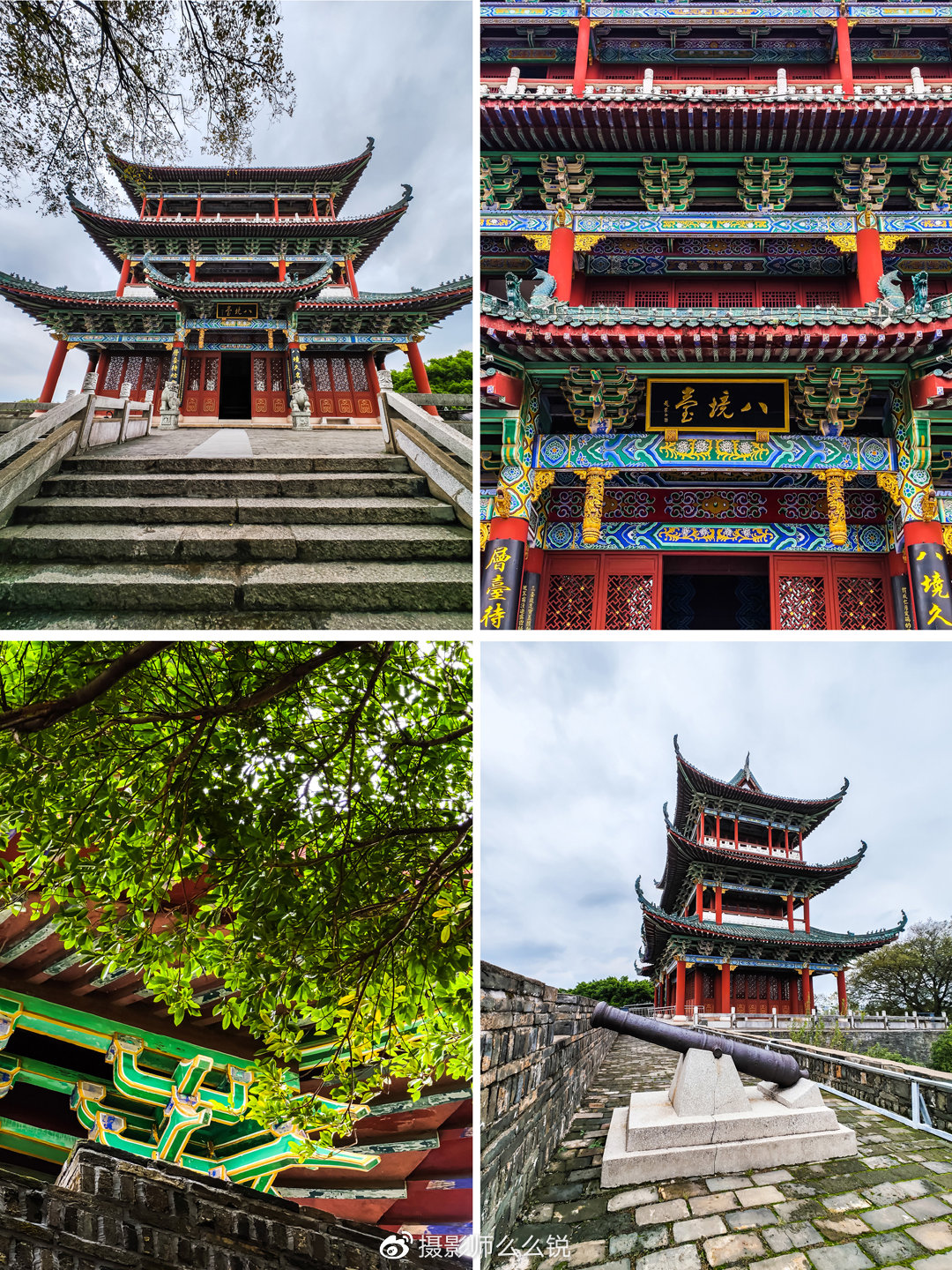
Zhixi Valley’s ‘one industry driving multiple industries’ approach has cultivated a variety of characteristic homestay products, such as ‘homestay + camping’, ‘homestay + leisure picking’, ‘homestay + parent-child research and learning’, and ‘homestay + intangible cultural heritage experience’. Each of these experiences is imbued with the valley’s own distinct charm, making it a place that is hard to leave.
Our third stop is Huanghuawan Shared Village, where a tranquil pond at the edge of the village is complemented by a tie-dye workshop and a teahouse, offering numerous leisure spaces that exude a natural and rustic charm. These initiatives are driven by young people returning to their roots or those with a strong attachment to their hometowns. The materials used are locally sourced, and the atmosphere is one of self-sufficiency and abundance, making Huanghua Bay a prime example of rural tourism in southern Jiangxi.
After exploring these rural tourist attractions, I was struck by the freshness of the experiences they offered. Though there wasn’t any groundbreaking innovation in concept, the mentality of the initiators shone through, creating a sense of a secluded paradise. The hosts and managers were friendly and talkative, with a strong sense of belonging. Each village, nestled in the valleys, had its own unique characteristics, reflecting the government’s dedicated support and active development efforts, which made the experience truly delightful.
Huanghua Bay Shared Village, located in Huanghua Group, Liantang Village, Dujiang Town, has been recognized as one of the ‘Most Beautiful Villages in Southern Jiangxi’ and ‘Top Eight New Scenic Spots of Longnan’. It is a village designed for people from all walks of life to fulfill their nostalgia. Here, one can relive the joys of childhood. Centered around the river embankment, it forms a fishbone-like layout with southern residences and northern landscapes. Along the south side of the embankment, there are scattered courtyard gates, cultural signs, yards, and houses; while the north side features shaded trees, viewing platforms, riverside paths, resting chairs, fitness spots, and small landscape nodes, becoming a cultural landscape belt for light luxury leisure and riverside seclusion.
The creative teahouse owner has painted the southern Jiangxi dialect on the stone walls, which attracted us to read and laugh at the amusing translations. Brewing a cup of tea and painting a fan surface, the comfortable time made us reluctant to leave.
However, we were drawn to the legendary ‘Lei Cha’ and arrived at the fourth stop of the beautiful village, the ancient village of Yaxi. Yaxi Ancient Village is located in Longyuanba, Quannan County, Ganzhou, with the village dating back to the Ming Dynasty, and all villagers bearing the surname Chen. The most magnificent and famous structures in Yaxi Ancient Village are two Hakka enclosed houses built during the Qing Dynasty, consisting of Fuxing Enclosure and Yafen Enclosure, covering a total area of about 1010 square meters. Our Lei Cha experience took place here.
Fuxing Enclosure, with its red lanterns hanging high, exudes a strong festive atmosphere. Built during the Xianfeng period of the Qing Dynasty (1856), Fuxing Enclosure is a square-shaped rammed earth and brick wall structure, three stories high with 17 rooms on each floor. With its upturned eaves and corners, the design is simple yet gives a very solid impression. The rectangular ‘mouth’-shaped earth enclosure has four artillery corners, and along the central axis of the enclosure from south to north, there are a gate yard, a building gate, a hallway, a corridor, a patio, and a hall. The patio is tall and slender, with internal corridors on the second floor and above, making the design compact and unique. Inside the enclosure, there is a Hakka Folk Custom Museum, showcasing Hakka intangible cultural heritage, wedding customs, and traditional festivals.Taking photos and checking in at this location is a must, as it offers the perfect backdrop for creating memorable images. Yaxi Ancient Village is a treasure trove of cultural heritage, particularly known for its Lei Cha, which is considered one of the ‘living fossils of Chinese tea culture’. This unique tea, born in the Northern Song Dynasty and with a history spanning thousands of years, is a legacy of the Hakka people who migrated from the Central Plains to the south. The production process, from material selection to brewing, is distinctive and the term ‘Lei’ refers to the grinding of ingredients. Lei Cha is a healthful tea drink, made by grinding tea leaves, sesame seeds, peanuts, and other ingredients in a mortar and then washing it with boiling water. While the flavor may be an acquired taste for first-timers, it is an experience not to be missed.
Yaxi Ancient Village preserves the distinctive Hakka culture, with the Hakka Folk Museum showcasing traditional customs such as marriage, mountain songs, and festivals. The village is a testament to the rich cultural tapestry of the Hakka people.
Our journey through the beautiful countryside culminates at Dayu Yashan, where maintaining a leisurely mood is paramount. With its lush greenery and numerous homestays, including a large hotel complex, Dayu Yashan offers a tranquil escape. Visitors can indulge in farming and picking, immerse in the natural and relaxed environment, and savor fresh, authentic ingredients. Situated at 25 degrees north latitude, within the world’s golden ecological belt, Dayu Yashan boasts a 92.6% forest coverage rate and meets the national first-class standards for air, water, and soil quality. It is a national 4A-level tourist attraction, the first 5A-level rural tourist spot in Jiangxi, and a Chinese sports and leisure characteristic town. The highlight of my visit was the happy winter barbecue with friends in the evening, a perfect embodiment of the relaxed and leisurely state of Yashan, where one can drink and chat freely, letting all troubles fade away with the swaying of the hanging bridge and the flying ribbons.
The rich history of Ganzhou extends beyond the Song City relics in the urban area. The ‘Hakka Tulou’ is a unique representation of Hakka residential culture, and we visit Guanxi Xinwei in Ganzhou, which holds the Guinness World Record for the largest square Hakka Tulou. Guanxi Xinwei is a comprehensive overview of Hakka Tulou culture, being the most complete, largest, and most functional square Hakka residential building found and preserved in China to date. It is also a typical example of the ‘nine wells (buildings) and eighteen halls’ in traditional Gannan residential buildings. Gannan Hakka Tulou, along with Beijing’s Siheyuan, Shaanxi’s cave dwellings, Guangxi’s dry-column houses, and Yunnan’s single-stamp houses, are collectively known as ‘China’s five major characteristic traditional residential buildings’.
Built in the third year of the Jiaqing period of the Qing Dynasty by the renowned gentleman Xu Mingjun of Guanxi, Guanxi Xinwei is later referred to as ‘Xinwei’ to distinguish it from his old residence. The Tulou’s wall is made of rammed earth, with four corner watchtowers, many gun ports, and plum blossom gun holes, indicating a tight defense system. The main building consists of 124 rooms of various sizes, divided into lower hall, front hall, middle hall, and upper hall, integrating home, ancestral hall, and fort functions.
In front of the main hall of Guanxi Xinwei, a pair of stone lions guards the entrance, with the male lion on the left fierce and majestic, and the female lion on the right elegant and solemn. The door frame of the main hall features cylindrical stone carvings of Qian and Kun from the I Ching, and the stone piles under more than ten large wooden pillars in the hall are all carved with various patterns or texts. The side courtyards and rooms are adorned with many wooden carvings of animals such as dragons, tigers, qilin, and phoenixes. Currently, two elderly people in the main hall of Xinwei demonstrate the characteristics of Gannan intangible cultural heritage handicrafts, which is also very interesting.
Standing atop the vast and expansive Yunkuo Mountain, we find ourselves amidst the undulating Anyuan Sanbai Mountains. “Must protect the source of the Dongjiang River,” a phrase spoken by Premier Zhou, resonates with the significance of Ganzhou Anyuan Sanbai Mountains, where a single Dongjiang River flows to Hong Kong.Sanbai Mountains, located at the junction of Jiangxi, Guangdong, and Fujian provinces, is part of the eastern extension of the Wuyi Mountain range and the watershed between the Ganjiang River of the Yangtze River system and the Dongjiang River of the Pearl River system. As the source of water for Hong Kong, it is the most famous tourist resort in Anyuan. It offers many attractions such as the first waterfall of the Dongjiang River, a glass suspension bridge, boundless landscapes, and a vast expanse of greenery.
The majestic Fuzhengtang Waterfall is known as the “First Waterfall of the Dongjiang River,” and the rugged Handongtan is acclaimed as the “First Beach of the Dongjiang River.” Dongfeng Lake is surrounded by green mountains, reflecting the deep blue water; the Jiuqu Shibatan, with its dense arrangement of ponds and rapids, offers ever-changing scenery with every step; the Zhiyinquan cliffs rise steeply, with twin waterfalls echoing each other, truly a unique spectacle in the world; the San Die Yaochi, with its three falls and three ponds, is far from the mundane world, truly a fairyland on earth.
Sanbai Mountains boasts five major tourist areas including Fuzhaotang, Butterfly Grand Canyon (Jiuqu Stream), Dongfeng Lake, Yangtian Lake, and Jianfengbi, integrating the four natural wonders of mountain terrain, forest sea, waterfalls, and hot springs. The mountains, waters, forests, and stones are all beautiful, with a primitive, simple, and serene atmosphere. After a long cable car ride, one can see the scene of high mountains and flat lakes, which is truly magical.
As the most famous resort in Anyuan, Sanbai Mountains offers more than just beautiful mountains, rivers, and lakes. After climbing the mountains, we can quickly reach the Hot Spring River Valley not far from the foot of the mountain for a steaming hot spring SPA. The lush green mountains of Southern Jiangxi paired with the warm and unrestrained hot springs make this winter moment feel blissfully happy.
There is also an unmissable fairyland mountain in Southern Jiangxi, the Quannan Tianlong Mountain, where Wang Yangming, a famous philosopher, once climbed and left behind beautiful verses. Tianlong Mountain, named for its mountain peaks that rise like a soaring dragon, is steep and full of peculiar shapes, with cliffs rising on three sides and rugged rocks. It also has a connection with Jin Yong’s “Demi-Gods and Semi-Devils.” The Ming Dynasty philosopher Wang Yangming, upon seeing the peculiar rocks of Tianlong Mountain, spontaneously composed a poem: “Tianlong Mountain peaks pierce the clouds, Taojiang River meanders around the mountain, four seasons never fade into spring colors, a land of outstanding people and heroes.” From a distance, the main peak of Tianlong Mountain is situated in the center of a group of peaks resembling lotus petals. Because the mountaintop has steep peaks with rugged rocks, resembling a dragon about to soar, it is named “Tianlong Mountain.” The most recent internet sensation, however, is the sculpture named “Hand of the Earth.” Standing 186 meters above the valley floor and overlooking the vast expanse of ravines and forests, the scenery is all-encompassing. Cloud seas, Zen temples, mountain peaks, Buddha’s hand, and Mian Mountain are the fairyland-like appearances revealed by Tianlong Mountain when we visited.
The home of the world champion rock climber is also in Ganzhou. So besides mountains, rivers, and history, there are many more fun things to do in Ganzhou.
China (Quannan) Rock Climbing Town, the hometown of rock climbing world champion Zhong Qixin, has concentrated on creating a rock climbing theme with a rock climbing hotel, Yanyu Restaurant, rock climbing training base, water sports, outdoor expansion, and various exciting and thrilling businesses. The rock climbing training base here is divided into outdoor rock climbing and water rock climbing. The outdoor rock climbing covers an area of about 4000 square meters, with climbing walls featuring difficulty routes, speed routes, and bouldering, all built to international rock climbing competition standards. The Energy Building combines a rock climbing element style theme, integrating dining, drinking, entertainment, and leisure into a comprehensive building. It includes a buffet restaurant, supermarket, constant temperature wave pool, coffee and tea bar, VR technology 3D experience hall, multi-function classrooms, children’s indoor climbing park, children’s playground, high configuration, high appearance, large space, and more than a dozen amusement facilities. Let the children climb, crawl, slide, and run here without restraint, just for one word: fun. In this immersive sports and entertainment venue, the fun is also full of professional style. I highly recommend this place for families with boys, as it offers at least two or three days of entertainment without getting boring!Is there anything more thrilling than rock climbing? Of course, for me, it’s driving to the wild for outdoor off-roading at the Off-Road Park. Here, I have my favorite off-road motorcycles and muddy ADV tracks. The red soil of Southern Jiangxi is not only suitable for growing delicious navel oranges but also perfect for riding off-road motorcycles in the muddy jungle after the rain. I had a great time riding off-road bikes. The easy-to-operate four-wheel off-road motorcycles easily crushed the slippery muddy forest paths, crossing water pits, crossing mountains, and going down steep slopes. The fully armed feeling is also a bit cool and handsome. I had a great time playing.
In addition to off-road motorcycle crossing, there is also an ADV all-terrain vehicle track PK here, providing a deeper off-road vehicle crossing experience. In the primitive jungle of Southern Jiangxi, you can find the thrill of primitive wildness. It’s simply great.
After the excitement, let’s stay in the starry RV camp in the valley. With bonfires, barbecues, insect chirping, and bird singing, we can integrate into nature again and wait for a date with the vast galaxy.
It’s quite a dilemma to decide which type of RV to stay in. Too many choices are also a trouble. Hahaha.
Integrating into nature and returning to simplicity is a relaxing journey. Escaping the hustle and bustle of the city and experiencing a pastoral retreat. In Ganzhou, all of these can be realized one by one. Do you like such a Ganzhou?



